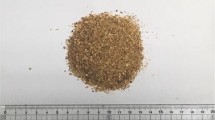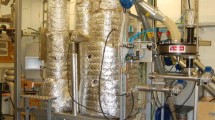Abstract
The gas produced in a biomass gasifier contains high amounts of tars which have to be removed prior to downstream utilization. Calcined dolomite is catalytically active for tar cracking reactions and resistant to sulfur poisoning. In this study, calcined dolomite was used as bed material in a reverse-flow reactor for cracking of tars in a model synthesis gas. 1-methylnaphthalene was used as model tar compound at a concentration of 15,000 mg/Nm3. The reactor system was operated at temperatures between 700 and 850 °C in the active zone. Total tar conversion was over 95 % for the system under reverse-flow conditions at the highest temperature. Already at the lowest temperature, up to 78 % of the 1-methylnaphthlene was converted, but mainly to other more stable tar compounds such as naphthalene and benzene, reaching a total tar conversion of only 23 %. To produce tar-free gas, higher temperatures are thus needed. The use of very high temperatures does, however, lead to a significant decrease in the specific area of the dolomite, as shown by BET surface measurements. The dolomite was further characterized with x-ray diffraction and energy dispersive spectroscopy.







Similar content being viewed by others
Notes
The definition of Evans and Milne states that “the organics, produced under thermal or partial-oxidation regimes (gasification) of any organic material, are called ‘tars’ and are generally assumed to be largely aromatic.”
A movie showing the flare is available as electronic supplementary material.
References
Albertazzi S, Basile F, Brandin J et al (2005) The technical feasibility of biomass gasification for hydrogen production. Catal Today 106:297–300. doi:10.1016/j.cattod.2005.07.160
Kumar A, Jones DD, Hanna MA (2009) Thermochemical biomass gasification: a review of the current status of the technology. Energies 2:556–581. doi:10.3390/en20300556
Damartzis T, Zabaniotou A (2011) Thermochemical conversion of biomass to second generation biofuels through integrated process design—a review. Renew Sustain Energy Rev 15:366–378. doi:10.1016/j.rser.2010.08.003
Kirubakaran V, Sivaramakrishnan V, Nalini R et al (2009) A review on gasification of biomass. Renew Sustain Energy Rev 13:179–186. doi:10.1016/j.rser.2007.07.001
Xu C, Donald J, Byambajav E, Ohtsuka Y (2010) Recent advances in catalysts for hot-gas removal of tar and NH3 from biomass gasification. Fuel 89:1784–1795. doi:10.1016/j.fuel.2010.02.014
Tunå P, Svensson H, Brandin J (2010) Modeling of reverse-flow partial oxidation process for gasifier product gas upgrading. Fifth International Conference on Thermal Engineering: Theory and Applications, Marrakesh
Evans RJ, Milne TA (1997) Chemistry of tar formation and maturation. In: Bridgwater A, Boocock D (eds) Developments in Thermochemical Biomass Conversion, vol 2. Blackie Academic & Professional, London, pp 803–816
Milne TA, Abatzoglou N, Evans RJ (1998) Biomass gasifier “tars”: their nature, formation, and conversion. NREL/TP-570-25357. National renewable energy laboratory, Golden, doi: 10.2172/3726
Anis S, Zainal ZA (2011) Tar reduction in biomass producer gas via mechanical, catalytic and thermal methods: a review. Renew Sustain Energy Rev 15:2355–2377. doi:10.1016/j.rser.2011.02.018
Abu El-Rub Z, Bramer EA, Brem G (2004) Review of catalysts for tar elimination in biomass gasification processes. Ind Eng Chem Res 43:6911–6919. doi:10.1021/ie0498403
Zhang R, Brown RC, Suby A, Cummer K (2004) Catalytic destruction of tar in biomass derived producer gas. Energy Convers Manag 45:995–1014. doi:10.1016/j.enconman.2003.08.016
Yung MM, Jablonski WS, Magrini-Bair KA (2009) Review of catalytic conditioning of biomass-derived syngas. Energy Fuel 23:1874–1887. doi:10.1021/ef800830n
Dayton D (2002) A review of the literature on catalytic biomass tar destruction milestone completion report. NREL/TP-510-32815. National Renewable Energy Laboratory, Golden
Olivares A, Aznar MP, Caballero MA et al (1997) Biomass gasification: produced gas upgrading by in-bed use of dolomite. Ind Eng Chem Res 36:5220–5226. doi:10.1021/ie9703797
Orío A, Corella J, Narváez I (1997) Performance of different dolomites on hot raw gas cleaning from biomass gasification with air. Ind Eng Chem Res 36:3800–3808. doi:10.1021/ie960810c
Delgado J, Aznar MP, Corella J (1996) Calcined dolomite, magnesite, and calcite for cleaning hot gas from a fluidized bed biomass gasifier with steam: life and usefulness. Ind Eng Chem Res 35:3637–3643. doi:10.1021/ie950714w
Simell PA, Hepola JO, Krause AOI (1997) Effects of gasification gas components on tar and ammonia decomposition over hot gas cleanup catalysts. Fuel 76:1117–1127. doi:10.1016/S0016-2361(97)00109-9
Świerczyński D, Libs S, Courson C, Kiennemann A (2007) Steam reforming of tar from a biomass gasification process over Ni/olivine catalyst using toluene as a model compound. Appl Catal B Environ 74:211–222. doi:10.1016/j.apcatb.2007.01.017
Zhao Z, Kuhn JN, Felix LG et al (2008) Thermally impregnated Ni–Olivine catalysts for tar removal by steam reforming in biomass gasifiers. Ind Eng Chem Res 47:717–723. doi:10.1021/ie071089l
Kuhn JN, Zhao Z, Senefeld-Naber A et al (2008) Ni-olivine catalysts prepared by thermal impregnation: structure, steam reforming activity, and stability. Appl Catal A Gen 341:43–49. doi:10.1016/j.apcata.2007.12.037
Li C, Suzuki K (2009) Tar property, analysis, reforming mechanism and model for biomass gasification—an overview. Renew Sustain Energy Rev 13:594–604. doi:10.1016/j.rser.2008.01.009
Han J, Kim H (2008) The reduction and control technology of tar during biomass gasification/pyrolysis: an overview. Renew Sustain Energy Rev 12:397–416. doi:10.1016/j.rser.2006.07.015
Devi L, Ptasinski KJ, Janssen FJJG (2003) A review of the primary measures for tar elimination in biomass gasification processes. Biomass Bioenergy 24:125–140. doi:10.1016/S0961-9534(02)00102-2
Matros YS, Bunimovich GA (1995) Control of volatile organic compounds by the catalytic reverse process. Ind Eng Chem Res 34:1630–1640. doi:10.1021/ie00044a016
Matros YS, Bunimovich GA (1996) Reverse-flow operation in fixed bed catalytic reactors. Catal Rev 38:1–68. doi:10.1080/01614949608006453
Haynes TN, Georgakis C, Caram HS (1992) The application of reverse flow reactors to endothermic reactions. Chem Eng Sci 47:2927–2932. doi:10.1016/0009-2509(92)87153-H
Van de Beld L, Wagenaar BM, Prins W (1997) Cleaning of hot producer gas in a catalytic adiabatic packed bed reactor with periodic flow reversal. In: Bridgwater AV, Boocock DGB (eds) Developments in thermochemical biomass conversion, vol 2. Blackie Academic & Professional, London, pp 907–920
Svensson H, Tunå P, Hulteberg C, Brandin J (2012) Modeling of soot formation during partial oxidation of producer gas. Fuel 106:271–278. doi:10.1016/j.fuel.2012.10.061
Myrén C, Hörnell C, Björnbom E, Sjöström K (2002) Catalytic tar decomposition of biomass pyrolysis gas with a combination of dolomite and silica. Biomass Bioenergy 23:217–227. doi:10.1016/S0961-9534(02)00049-1
Barrett EP, Joyner LG, Halenda PP (1951) The determination of pore volume and area distributions in porous substances. I. Computations from nitrogen isotherms. J Am Chem Soc 73:373–380. doi:10.1021/ja01145a126
Halsey G (1948) Physical adsorption on non-uniform surfaces. J Chem Phys 16:931. doi:10.1063/1.1746689
Aldén H, Björkman E, Carlsson M, Waldheim L (1994) Catalytic cracking of naphthalene on dolomite. In: Bridgwater AV (ed) Advances in thermochemical biomass conversion, vol 1. Blackie Academic & Professional, London, pp 216–232
Garcia XA, Hüttinger KJ (1989) Steam gasification of naphthalene as a model reaction of homogeneous gas/gas reactions during coal gasification. Fuel 68:1300–1310. doi:10.1016/0016-2361(89)90246-9
Devi L, Ptasinski KJ, Janssen FJJG (2005) Pretreated olivine as tar removal catalyst for biomass gasifiers: investigation using naphthalene as model biomass tar. Fuel Process Technol 86:707–730. doi:10.1016/j.fuproc.2004.07.001
Coll R, Salvadó J, Farriol X, Montané D (2001) Steam reforming model compounds of biomass gasification tars: conversion at different operating conditions and tendency towards coke formation. Fuel Process Technol 74:19–31. doi:10.1016/S0378-3820(01)00214-4
Boucif F, Marouf-Khelifa K, Batonneau-Gener I et al (2010) Preparation, characterisation of thermally treated Algerian dolomite powders and application to azo-dye adsorption. Powder Technol 201:277–282. doi:10.1016/j.powtec.2010.04.013
Sasaki K, Qiu X, Hosomomi Y et al (2013) Effect of natural dolomite calcination temperature on sorption of borate onto calcined products. Microporous Mesoporous Mater 171:1–8. doi:10.1016/j.micromeso.2012.12.029
Ávila I, Crnkovic PM, Milioli FE, Luo KH (2012) Investigation of the pore blockage of a Brazilian dolomite during the sulfation reaction. Appl Surf Sci 258:3532–3539. doi:10.1016/j.apsusc.2011.11.108
Acknowledgments
The research was funded by the Swedish energy Agency through the Swedish Gas Technology Centre and the Danish Gas Technology Centre, in cooperation with the industrial partners ABB Corporate Research, Alufluor AB, E.ON Gasification Development AB, E.ON Sverige AB, Göteborg Energi AB, Statoil ASA, Stockholm Gas AB, Tekniska Verken i Linköping AB, ÅForsk, and Öresundskraft AB.
Author information
Authors and Affiliations
Corresponding author
Electronic supplementary material
Below is the link to the electronic supplementary material.
(MPG 6556 kb)
Rights and permissions
About this article
Cite this article
Tunå, P., Bauer, F., Hulteberg, C. et al. Regenerative reverse-flow reactor system for cracking of producer gas tars. Biomass Conv. Bioref. 4, 43–51 (2014). https://doi.org/10.1007/s13399-013-0088-0
Received:
Revised:
Accepted:
Published:
Issue Date:
DOI: https://doi.org/10.1007/s13399-013-0088-0




